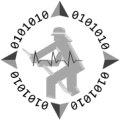FeuerWhere Joint-Project
 More information at
More information at
http://www.feuerwhere.de
Abstract
The Berlin fire brigade handles about 300 000 incidents per year. Especially fire fighting exposes rescue forces to high risks and requires them to go up to and beyond their physical limits. In strong smoke emissions the forces have to explore buildings with almost no sight. Usually only a rough plan is available for a disaster site and buildings to aid in orientation.
Command control has to manage the operation on pieces of information from radio communication and sketches. The location of the rescue forces inside buildings, their vital state and environments parameters can only be guessed very roughly from the available pieces of information.In the joint-project FeuerWhere, we will research the use of technical devices to improve this lack of information from 2008 until 2010. We will use wireless, self-configurating sensor networks to ensure independence of any existing infrastructure at the disaster site.
The project goal is to develop a solution that is capable of monitoring the location and vital state of rescue forces as well as current environmental parameters continuously. This system must be designed for ad-hoc setup and consecutive extension during the incident. The main research focus is the localisation of rescue forces in realistic environments and buildings. A central technology used for localisation are NanoLOC transceivers, which allow distance estimations by time of arrival measurements. The ScatterWeb sensor network needs to provide a stable backbone even in harsh environments. An additional wireless body-area network is used to gather vital information and environment parameters. All information is provided at a central station to support incident control in potentially vital decision. To provide mobile access for rescue forces the system, a TETRA gateway will be built.
Kurzbeschreibung
Die Berliner Feuerwehr rückt jährlich zu etwa 300.000 Einsätzen aus. Insbesondere bei der Brandbekämpfung setzen sich die Rettungskräfte besonderen Risiken aus und gehen an ihre körperlichen Grenzen. Bei starker Rauchentwicklung müssen die Einsatzkräfte Gebäude praktisch blind erkunden. Zur Orientierung liegt meist nur ein grober Lageplan des betroffenen Gebäudes vor.
Die Einsatzleitung erhält ihre Lageinformationen über Lageskizzen und Sprechfunk. Die Position der Einsatzkräfte und ihr körperlicher Zustand können aus diesen bruchstückhaften Informationen nur sehr grob abgeschätzt werden. Im Verbundvorhaben FeuerWhere soll in den Jahren 2008 bis 2010 der Einsatz technischer Hilfsmittel zur Verringerung dieses Informationsdefizites erforscht werden. Hierzu kommen drahtlose, selbstkonfigurierende Sensornetzwerke zum Einsatz, um die Unabhängigkeit von existierender Infrastruktur zu gewährleisten.
Projektziel ist es, eine prototypische Lösung zu entwickeln, welche in der Lage ist, die Position der Einsatzkräfte, deren Vitalzustand und die aktuellen Umweltparameter fortlaufend zu überwachen. Dass System muss ad-hoc aufgebaut und sukzessive ergänzt werden können. Forschungsschwerpunkt ist die Lokalisierung der Einsatzkräfte unter Einsatzbedingungen und in Gebäuden. Eine wesentliche Technologie die dabei zum Einsatz kommt, sind NanoLOC Transceiver, die Signallaufzeitmessungen ermöglichen. Das ScatterWeb Sensornetzwerk muss auch unter Einsatzbedingungen stabilen Datenaustausch ermöglichen. Ein zusätzliches körpernahes Sensornetz wird zur Erfassung von Vitaldaten eingesetzt. Alle Informationen werden zentral zur Verfügung gestellt, um die Einsatzleitung zeitnah bei potentiell lebenswichtigen Entscheidungen zu unterstützen. Als Verbindung zu den Einsatzkräften wird das System an TETRA Digitalfunktechnik angebunden.
Project coordinator
- Freie Universität Berlin, Institut für Informatik, Computer Systems and Telematics department
- Contact: Michael Baar
Project partners
- Berliner Feuerwehr
- IHP - Innovations for High Performance Microelectronics Frankfurt (Oder)
- MSA AUER GmbH (Berlin)
- Nanotron Technologies GmbH (Berlin)
Associated project partners
- TimeKontor AG (Berlin)
- MPA Technologies Ltd. (Israel)
Contact: Michael Baar